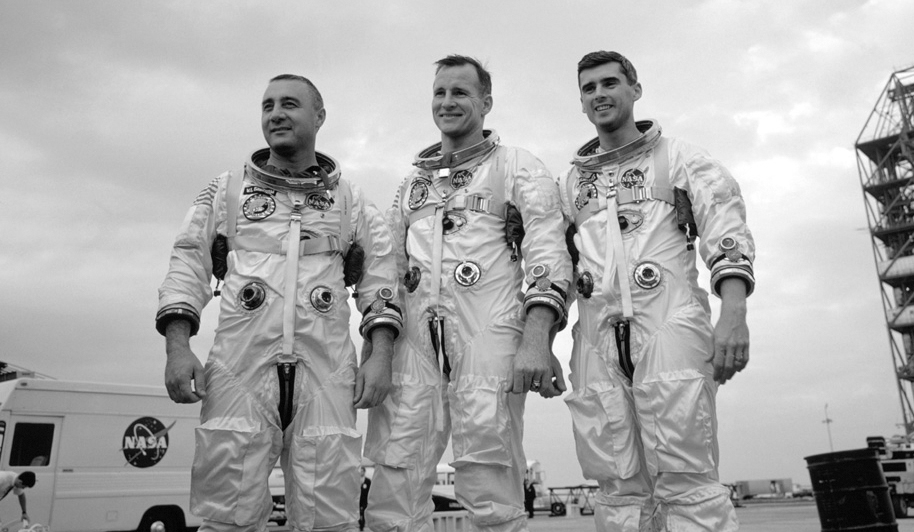1967
Ad astra per aspera. —Latin proverb, meaning “A rough road leads to the stars”
With actual moon missions now firmly in NASA’s sights, both the United States and the USSR began pushing themselves to the limit in hopes of being the first world power to put a person on the lunar surface. Unfortunately, this rush to be first caused both countries to get sloppy, and this led to extreme tragedies on both sides.
The follow-up program to Gemini was known as Apollo—named after the mythological Greek god of the sun. Because the Apollo missions were designed to be in space for extended periods, land on the moon’s surface, and then get the astronauts back home safely, a larger ship would be needed. So Wernher von Braun and his team began work on creating the largest and most powerful rocket the world had ever seen: a behemoth known as the Saturn V.

The Apollo Saturn V spacecraft basically was designed to work like this: A command module and service module (called the CSM when combined, or the CM and SM when separated) would be loaded with a three-man crew, attached to a lunar landing module (LM, pronounced “Lem”), and then all that would be stuck on top of a ginormous 363-foot, three-stage Saturn V rocket and blasted into Earth’s orbit at incredible speeds.
Once the first stage of the Saturn V rocket was out of fuel, it would break off, and the CSM/LM would circle the Earth twice, still attached to the second stage of the Saturn V. If all systems seemed to be working okay, the Saturn V would engage stage-two thrusters and blast toward the moon at thousands of miles per hour. When stage two ran out of fuel, it would break off as well, leaving just the CSM/LM hurtling toward the moon.
After two or three days’ journey, the CSM would arrive in the moon’s orbit. Two of the crew would then get into the LM, land it on the moon (not an easy task), and then walk (bounce) around to see what it was like. Once the astronauts on the surface planted a flag and collected some moon rocks, they’d get back into the LM and blast back into orbit. The astronaut in the CSM would find the LM in orbit, dock with it (this is why docking was such a big part of the Gemini program), and bring the crew back aboard the CSM; and then the CSM would disconnect the LM and fly back to Earth by itself. The CSM would spend another two or three days hurtling back toward Earth, enter Earth’s orbit, and parachute into the ocean to be recovered by the navy.
That was the plan, at least.
If that sounds incredibly complicated, that’s because it was. Keep in mind, also, that these guys are doing this twenty years before the invention of the first Mac computer. Rocket scientists were still solving complex physics and calculus equations using a pencil and paper.
NASA spent months testing the rocket systems and training the first astronauts to undertake an Apollo mission. The crew it settled on were Gus Grissom (the second American in space), Ed White (the astronaut who did America’s first space walk), and Roger B. Chaffee, a pilot who had been in Mission Control for a number of Gemini missions. Apollo 1 was scheduled to launch on February 21, 1967—the first test run of a mission that hoped to put an American on the moon.
But the mission never launched.
On January 27, 1967, during a systems test in Cape Canaveral, the three astronauts of Apollo 1 entered the CSM to perform a full systems test. During the test, an electrical power failure created a spark that ignited the oxygen-rich environment of the CSM, immediately becoming a raging fire that spewed thick black smoke throughout the cockpit. The crew, still strapped into their seats, were unable to eject through the hatches before they succumbed to the smoke and fire. The emergency hatch wouldn’t open because it had been designed not to blow open accidentally as it had during the Liberty Bell 7 mission. All three men died. They would be the first Americans to die in the space program, and the loss of these heroes completely shocked and saddened the entire country.


Three months later, the USSR had a tragedy in its lunar program as well. The Soviet leadership knew it had fallen behind in the space race, so instead of pursuing its own version of Project Gemini, it went straight into an attempt to build a lunar landing module. The Soviet moon-landing program was based around the Soyuz spacecraft. It had a two-man crew, complete with a landing module that would send one member of that crew to the surface of the moon. In their rush to make such a gigantic leap forward in their program, however, the Soviets ended up pushing themselves beyond what many of their cosmonauts believed was safe.

The crew of Apollo 1
On April 23, 1967, Soyuz 1 launched. Its pilot was veteran cosmonaut and hero of the Soviet Union Vladimir Komarov, a man who had commanded the historic Voskhod 1 mission three years earlier. Soyuz 1 ran into trouble almost immediately. As soon as the ship reached Earth’s orbit, it was supposed to deploy solar panels to collect energy from the sun, but one of the panels failed to open because of a mechanical error. Komarov stayed cool under pressure, but then a thruster malfunctioned as well, causing Soyuz 1 to start spinning as Gemini 8 had. Komarov used a strategy similar to Neil Armstrong’s to quickly correct the roll, but as you can probably imagine, he wasn’t really too excited about hanging out in space in a craft that had already malfunctioned twice. He aborted the mission and reentered Earth’s atmosphere.
Unfortunately, his ship let him down a third time. Its parachute didn’t open.
Komarov fired Soyuz 1’s backup chute to try to slow the craft’s speed as it careened toward Earth, but the reserve chute got tangled up and didn’t deploy correctly. Soyuz 1 crashed into the Russian countryside and exploded. Komarov would be the first person to die on a spaceflight mission.

Together, these tragedies almost killed the space programs of both countries.
But the brave astronauts who had performed these dangerous missions over the last six years hadn’t come this far just to lie down and quit with the moon so close in their sights. Every astronaut knew this was dangerous, groundbreaking work that no human had ever attempted before, and they knew they were putting their lives on the line every single time they heard the phrase blast off.
If flying to the moon was as easy as sitting on your couch playing a sci-fi spaceship video game, anyone would be able to do it.
These astronauts and cosmonauts weren’t just anyone. They were pioneers. They wanted to break barriers that had existed for millennia, explore new lands, and do the things that nobody had ever even dreamed was possible. And that’s not always safe.
Instead of giving up, both nations took the next year and a half to improve, redesign, and reorganize their missions. The United States launched Apollo 2 through Apollo 6 as unmanned tests of the equipment, and the USSR dedicated all its resources to improving the Soyuz craft. Both the United States and the USSR were intent on their desire to reach the moon, but not at the expense of human life. Both countries had suffered horrible catastrophes and would do everything they could to make sure it would never happen again.